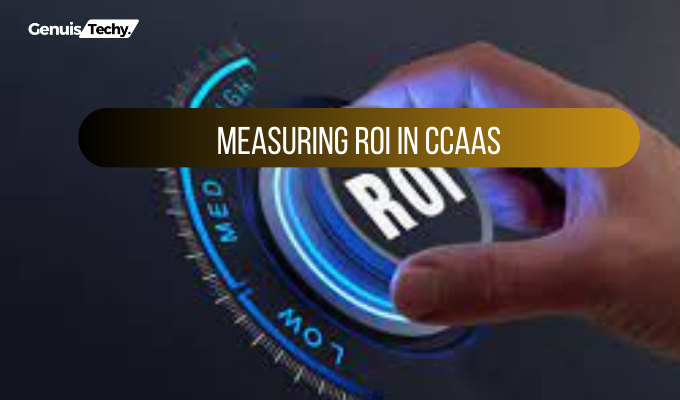Welcome to the world of cloud-based communication solutions! Have you ever wondered how investing in a Contact Center as a Service (CCaaS) platform can impact your business’s bottom line? Well, you’re in the right place. Today, we’re diving into the fascinating realm of Measuring ROI in CCaaS.
Picture this: You’ve just implemented a CCaaS system, streamlining customer interactions and improving agent efficiency. But how do you know if it delivers value to your organization? Measuring ROI in CCaaS is like putting on glasses that reveal the hidden insights behind every customer call, chat, or email.
By delving into the intricacies of CCaaS ROI measurement, we uncover the real impact of your investment. From increased customer satisfaction to reduced operational costs, each metric tells a story of success. Join us as we demystify the process of Measuring ROI in CCaaS and empower you to make informed decisions that drive business growth. Our journey together will be enlightening.
Understanding: Measuring ROI in CCaaS
Before delving into measuring ROI, it’s crucial to grasp the fundamentals of CCaaS. CCaaS, or Contact Center as a Service, is a cloud-based solution that provides businesses with tools for managing customer interactions. It offers features like call routing, IVR (Interactive Voice Response), omnichannel support, and analytics, all accessible through a subscription model.
Determine Your Objectives:
Start by defining your goals for implementing CCaaS. Are you aiming to enhance customer satisfaction, reduce operational costs, or improve agent productivity? Clearly outlining your objectives will guide your ROI measurement process and help you focus on relevant metrics.
Calculate Cost Savings:
One of the key benefits of CCaaS is its potential for cost savings. Calculate the expenses associated with traditional contact center operations, including infrastructure, hardware, software licenses, and maintenance. Then, compare these costs with the subscription fees and operational expenses of CCaaS. The difference represents your cost savings, a critical component of ROI measurement.
Assess Productivity Gains:
CCaaS can significantly boost agent productivity through features like automatic call distribution, real-time analytics, and workforce optimization tools. Evaluate metrics such as average handling time, first call resolution rate, and agent utilization to quantify the productivity gains achieved with CCaaS. By analyzing these metrics, you can determine how effectively the platform streamlines operations and improves overall efficiency.

Analyzing Customer Satisfaction:
One crucial aspect of measuring ROI in CCaaS is evaluating its impact on customer satisfaction. Utilize customer feedback surveys, net promoter scores (NPS), and customer satisfaction scores (CSAT) to gauge how well the CCaaS platform is meeting the needs and expectations of your customers. By tracking changes in satisfaction metrics before and after implementing CCaaS, you can quantify its contribution to overall customer happiness.
Monitoring Service Level Agreements (SLAs):
Effective CCaaS solutions help organizations meet and exceed service level agreements (SLAs) by ensuring timely response and resolution of customer inquiries. Monitor key SLA metrics such as average response, resolution, and adherence to SLA targets. Analyzing SLA performance provides insights into the efficiency and effectiveness of the CCaaS platform in delivering high-quality customer service.
Analyzing Data Analytics and Insights:
CCaaS platforms offer robust analytics capabilities, providing valuable insights into customer interactions, agent performance, and operational efficiency. Leverage data analytics tools to analyze call volumes, wait times, customer demographics, and agent productivity. By extracting actionable insights from this data, you can identify areas for improvement and optimize resource allocation to maximize ROI.
Factoring in Scalability:
Scalability is a critical factor in determining the long-term ROI of CCaaS investments. Evaluate the platform’s ability to scale with your business growth and evolving customer demands. Assess factors such as ease of adding new users, expanding capacity, and integrating additional communication channels. A scalable CCaaS solution ensures flexibility and agility to adapt to changing business requirements while maintaining cost-effectiveness.
Calculating the Return on Investment:
Finally, calculate the return on investment (ROI) of your CCaaS implementation by comparing the financial benefits achieved with the costs incurred. Consider both tangible benefits such as cost savings and productivity gains, as well as intangible benefits like improved customer loyalty and brand reputation. Use ROI formulas such as (Net Benefits / Costs) x 100 to quantify the ROI percentage. By accurately measuring ROI, you can demonstrate the value of CCaaS to key stakeholders and drive informed decision-making within your organization.
Conclusion:
In Conclusion, measuring ROI in CCaaS provides invaluable insights into the effectiveness and value of adopting cloud-based contact center solutions. By assessing factors like customer satisfaction, SLA adherence, data analytics, scalability, and financial returns, businesses can optimize their investment and drive operational excellence, ultimately enhancing customer experiences and fostering long-term success.
FAQs:
Q.1: How do you track ROI?
To track ROI, you compare the financial benefits gained from an investment to the costs incurred. This involves calculating the return on investment percentage using a simple formula: (Net Benefits / Costs) x 100
Q.2: Is ROI an external KPI?
No, ROI is not an external KPI. It’s an internal metric used to measure the profitability and efficiency of investments or initiatives within a company.
Q.3: What is the formula for ROI in digital marketing?
The formula for ROI in digital marketing is simple: ROI = (Revenue – Cost) / Cost.
Q.4: What are metrics measurements and ROI?
Metrics are measurements used to evaluate performance or track progress toward specific goals. They provide quantifiable data that helps businesses assess various aspects of their operations.
ROI, or Return on Investment, is a financial metric that calculates the profitability of an investment relative to its cost. It measures the gain or loss generated from an investment compared to its initial expense.
In simple terms, metrics are the tools used to measure performance, while ROI assesses the financial outcome of an investment. Both are essential for gauging success and making informed decisions in business.